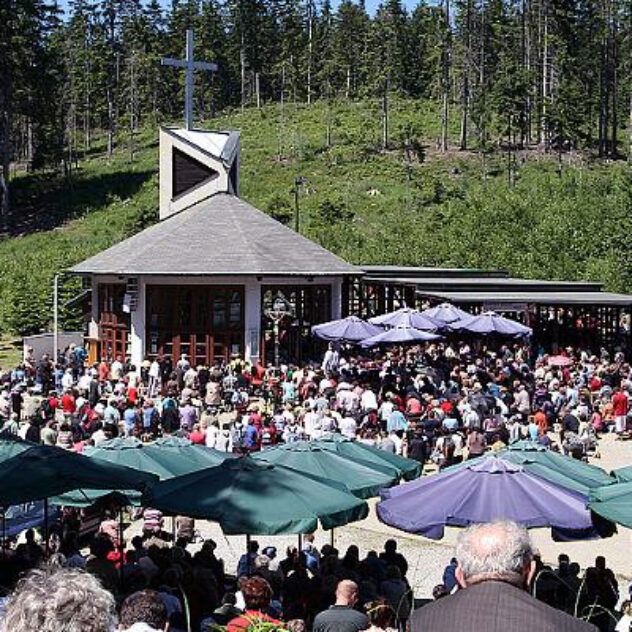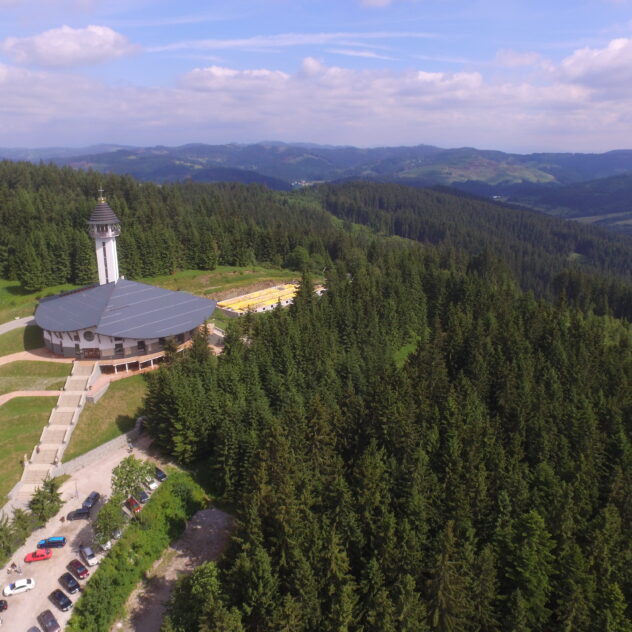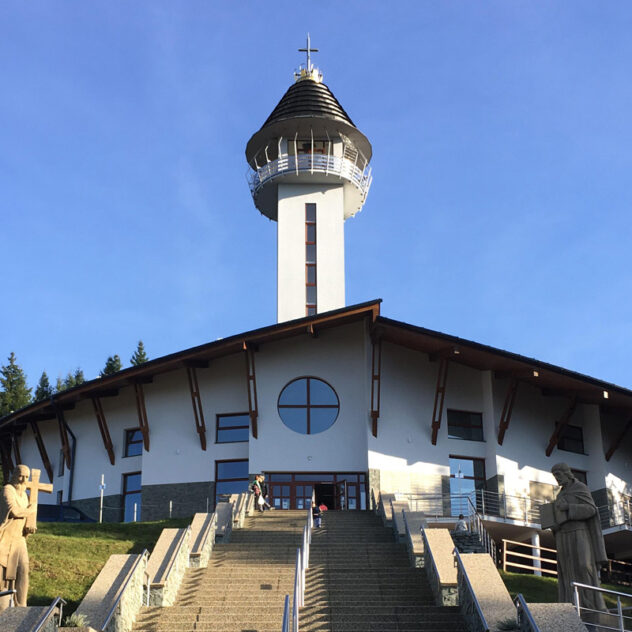Turzovka - Vrch Živčáková
Information about the pilgrimage site
This Slovak pilgrimage site is also popularly known as “Slovak Lourdes”. Hora Živčáková has been known as a place of prayer and Marian veneration since time immemorial. In fact, a picture of the Virgin Mary has always been found on a tree in the forest at this place. Passing locals used to stop by it and pray. In 1958, however, unusual events took place in this place: according to the words of the grove owner Matúš Lašut, Our Lady of Lourdes was about to appear to him.
Since these times, believers from near and far began to visit Hora Živčáková in even greater numbers. The prayers of many have been answered and the rumour that the water from the local springs has healing properties is widespread. What is remarkable about the whole story of the pilgrimage site, however, are the socio-political circumstances of the time. At the time of the alleged apparition, a communist regime was raging in Slovakia, which was very harsh in the nearby village of Turzovka: the property of all private enterprises (shops, brickyard, carpentry and many other establishments) was nationalized, and many people lost their possessions. These acts were very unjust, and other injustices were committed against Christians: many were arrested and subsequently imprisoned for their anti-communist attitudes. The extermination efforts were also transferred to the site of the apparition on Mount Živčáková: the communists often resorted to burning paintings and statues, especially before church festivals. Also, Matúš Lašut himself was investigated by public security and sent for psychiatric examinations several times.
It is remarkable that the pilgrimage of the faithful to Mount Živčáková persisted throughout the entire totalitarian communist regime, and that the pilgrimage to the mountain was made privately and in greater numbers. Pilgrims were not deterred even by intimidation and persecution by the state authorities. The long-lasting high attendance at the pilgrimage site was certainly a strong reason why the pilgrimage site has already been approved by the Church (2008), although the investigation into the circumstances of the apparitions of the Virgin Mary is still ongoing.
Today on Mount Živčáková there is a newly built Church of Our Lady Mother of the Church (consecrated in 2015), the Chapel of Our Lady Queen of Peace (from 1993) and wells with spring water, which many believe to have healing effects.
Tourist attractions in the vicinity
Megoňky Geopark – near the village of Milošová there is a rare natural monument: unusual stone spheres, which are a rare European and even world uniqueness. This site is the largest of its kind in Europe. These rock balls are almost perfectly shaped and vary in size from 30 centimetres to more than 3 metres. Their origin is still not scientifically explained. The most probable theory is that they were formed by the gradual packing of their core by the movements of the water on the seabed. Today, the site is connected by a cycle path to the neighbouring Czech village of Mosty u Jablunkova.
Trojmedzie – this is the place where the borders of Slovakia, Czech Republic and Poland meet. From this point, 541 km of the Slovak-Polish and 251 km of the Slovak-Czech border continue. At Trojmedzie you can experience a unique experience – to stand in three countries at once. It is a regular meeting place for friends from neighbouring countries and various events take place here, e.g. New Year’s Eve at Trojmedzí, a tourist march through the three European states, the Eucharist celebration at Trojmedzí, the Goral Marathon and others (www.regionkysuce.sk).
Vysoká nad Kysucou – in this typical Kysuce village, which is large and consists of several hills, you can visit several attractions. The E. A. Cernan, who is a descendant of the natives of Vysoká nad Kysucou. He was an American astronaut who was a participant in the Apollo 17 mission. At the end of the last ascent to the lunar surface, he was the last to return to the lunar module, thus becoming the last man to walk on the moon. Another interesting feature is the sundial, which is located in the small square in front of the municipal office. They are surrounded by “space” sculptures from the sculpture symposium “From tinker to astronaut”. The village is famous for its tinkering tradition. In the centre of the village, near St Matthew’s Church, is the remarkable Bible Garden, which was created in 2021 during the COVID-19 pandemic. It is unique in that it contains all the plants mentioned in the Bible and other Christian holy books.
The Slovak Astronomical Clock in Stara Bystrica – one of the youngest astronomical clocks in the world and the first in Slovakia (it was completed in 2009). It is also the largest wooden statue in Slovakia. The overall composition represents the seated Madonna, the Virgin Mary of the Seven Sorrows, the patron saint of Slovakia. The heart of the astronomical clock is the astronomical clock. From it one can find out several data: the solar time, the position of the sun and the moon, the phases of the moon or the date. The astronomical clock strikes every full hour from 8:00 to 22:00, when the statues of the seven saints associated with Slovakia are set in motion: Cyril, Methodius, Ondrej Svorad, Benedict, Gorazd, Bystrik and Vojtech. There are two bells in the tower of the astronomical clock (https://www.orloj.sk/).
Kysuce Village Museum in Vychylovka – this unique museum in the nature was established in 1974. There are up to 34 moved buildings from Kysuce villages that were flooded due to the construction of the Nová Bystrica water reservoir. These are residential houses, farm buildings, a tavern, mills and also a brick chapel from Zborov nad Bystrica. One of the unique attractions is a functioning historical forest railway with a train, which visitors can take through the beautiful countryside to the Beskydy saddle, where it connects with the Orava Forest Railway. During the high season (May – October), the museum hosts many accompanying programmes: performances by folklore ensembles and folk music typical of the Kysuce region.
More tourist attractions in the vicinity of the pilgrimage site Hora Živčáková can be found on the website:
- Regional Tourism Organization (https://zilinskyturistickykraj.sk/).
- Kysuce Regional Tourism Organisation (https://www.regionkysuce.sk/en/)
Accommodation
- Accommodation for pilgrims: currently under construction is the “Marta” Exercises and Pastoral House
- Accommodation in the surrounding villages, the closest are Turzovka, Korňa and Vysoká na Kysucou
Availability
By car
Access by car is the fastest. A suitable starting point for climbing Mount Živčák is the village of Korňa (district Čadca). From this village there is a well-groomed access road, the traffic flow is controlled by traffic lights. There is a parking lot near the Church of Our Lady Mother of the Church.
By public transport
One option is to travel by train to the Turzovka station stop. From the station continue on foot across the cross road to Mount Živčáková. This walking route is approximately 3 kilometres long. Another option is to travel by bus to the village of Korňa and from there walk to Mount Živčáková along the asphalt road, which is also the access road to the pilgrimage site for cars.
On foot
There are several hiking trails leading to the Živčáková Mountain. They lead both from Turzovka and Korňa. The ascent takes about an hour. The trails are well marked and are available in various hiking maps.
On a bicycle
The climb up the mountain begins at the turn off the main road leading through the village of Korňa. Unless there is a traditional pilgrimage, traffic is not heavy. The average gradient of the hill is up to 9% for 2 km, but short uphill sections with gradients from 10 to 15% alternate with shorter straight sections at short intervals. The last 800 metres is just a longer straight (https://www.cyklokopce.sk/zivcakova/).








